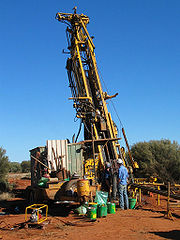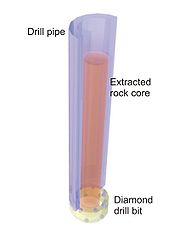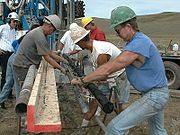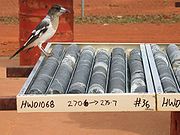
Exploration diamond drilling
Encyclopedia

Ore
An ore is a type of rock that contains minerals with important elements including metals. The ores are extracted through mining; these are then refined to extract the valuable element....
deposits and potential sites. By withdrawing a small diameter core of rock from the orebody, geologists can analyze the core by chemical assay
Metallurgical assay
A metallurgical assay is a compositional analysis of an ore, metal, or alloy.Some assay methods are suitable for raw materials; others are more appropriate for finished goods. Raw precious metals are assayed by an assay office...
and conduct petrologic
Petrology
Petrology is the branch of geology that studies rocks, and the conditions in which rocks form....
, structural and mineralogic
Mineralogy
Mineralogy is the study of chemistry, crystal structure, and physical properties of minerals. Specific studies within mineralogy include the processes of mineral origin and formation, classification of minerals, their geographical distribution, as well as their utilization.-History:Early writing...
studies of the rock.
History

Diamond
In mineralogy, diamond is an allotrope of carbon, where the carbon atoms are arranged in a variation of the face-centered cubic crystal structure called a diamond lattice. Diamond is less stable than graphite, but the conversion rate from diamond to graphite is negligible at ambient conditions...
drilling opened up many new areas for mineral mining, and was related to a boom in mineral exploration in remote locations. Before the invention of the portable diamond drill, most mineral prospecting was limited to finding outcrops at the surface and hand digging.
Diamond drilling

Drilling rig
A drilling rig is a machine which creates holes or shafts in the ground. Drilling rigs can be massive structures housing equipment used to drill water wells, oil wells, or natural gas extraction wells, or they can be small enough to be moved manually by one person...
) in that a solid core is extracted from depth, for examination on the surface. The key technology of the diamond drill is the actual diamond bit itself. It is composed of industrial diamonds set into a soft metallic matrix. As shown in the figure, the diamonds are scattered throughout the matrix, and the action relies on the matrix to slowly wear during the drilling, so as to expose more diamonds. The bit is mounted onto a drill stem, which is connected to a rotary drill. Water is injected into the drill pipe, so as to wash out the rock cuttings produced by the bit. An actual diamond bit is a complex affair, usually designed for a specific rock type, with many channels for washing.
The drill uses a diamond
Diamond
In mineralogy, diamond is an allotrope of carbon, where the carbon atoms are arranged in a variation of the face-centered cubic crystal structure called a diamond lattice. Diamond is less stable than graphite, but the conversion rate from diamond to graphite is negligible at ambient conditions...
encrusted drill bit
Drill bit
Drill bits are cutting tools used to create cylindrical holes. Bits are held in a tool called a drill, which rotates them and provides torque and axial force to create the hole. Specialized bits are also available for non-cylindrical-shaped holes....
(pictured on the right) to drill through the rock. The drill produces a "core" which is photographed and split longitudinally. Half of the split core is assayed
Metallurgical assay
A metallurgical assay is a compositional analysis of an ore, metal, or alloy.Some assay methods are suitable for raw materials; others are more appropriate for finished goods. Raw precious metals are assayed by an assay office...
while the other half is permanently stored for future use and reassaying if necessary. Although a larger diameter core is the most preferred it is the most expensive. The most common diameter sizes of core are NQ and CHD 76.
Core extraction

The photo shows the extraction of a core, using a triple-tube wire-line system, capable of extracting core under the worst conditions. This is very important when exploring fault zones such as the San Andreas Fault
San Andreas Fault
The San Andreas Fault is a continental strike-slip fault that runs a length of roughly through California in the United States. The fault's motion is right-lateral strike-slip...
.
Tube sizes
There are five major "wire line" tube sizes typically used. Larger tubes produced larger diameter rock cores and require more drill power to drive them. The choice of tube size is a trade-off between the rock core diameter desired and the depth that can be drilled with a particular drilling rig motor.Standard "Q" wire line bit sizes

| Size | Hole (outside) diameter, mm |
Core (inside) diameter, mm |
|---|---|---|
| AQ | 48 | 27 |
| BQ | 60 | 36.5 |
| NQ | 75.7 | 47.6 |
| HQ | 96 | 63.5 |
| PQ | 122.6 | 85 |
| CHD 76 | 75.7 | 43.5 |
| CHD 101 | 101.3 | 63.5 |
| CHD 134 | 134.0 | 85.0 |

